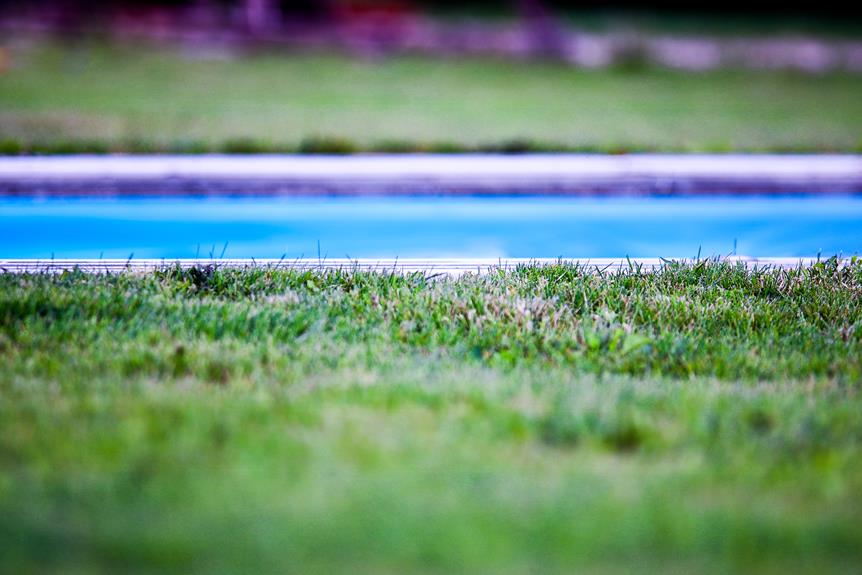Tired of a dirty, debris-filled pool? Want crystal-clear water that sparkles under the sun? Look no further! We’ll guide you through the process of manually vacuuming your pool, whether it’s above ground or inground. With our step-by-step instructions and necessary supplies, achieve a pristine swimming environment. From prep to vacuuming, we cover it all. And don’t worry, we’ll guide you through post-vacuuming maintenance too. Dive into a clean, refreshing pool by mastering the art of pool vacuuming!
Key Takeaways
- The supplies needed for manual pool vacuuming include a telescopic pole, vacuum head, skimmer attachment for vacuum, pool vacuum hose, and pool brush.
- Before vacuuming the pool, it is important to brush the sides and floor of the pool to dislodge algae and debris. Using pool flocculant can also help gather smaller particles for easier vacuuming.
- When vacuuming, start in the shallow end and work towards the deep end. Let the debris settle and vacuum again to ensure thorough cleaning. Using high suction can increase effectiveness, but be prepared for an arm workout.
- After vacuuming, it is important to vacuum the pool again after the debris has settled. Disassemble the manual vacuum, drain the remaining water in the hose, brush the pool a final time, clean out the skimmer and pump strainer basket, and restore the pool filter and pump settings to normal.
Equipment Needed for Vacuuming an Above Ground Pool
To vacuum your above ground pool, you will need a telescopic pole, vacuum head, skimmer attachment, pool vacuum hose, and pool brush. These essential tools will allow you to effectively clean your pool and maintain its cleanliness throughout the swimming season. The telescopic pole is adjustable in length, allowing you to reach all areas of your pool easily. The vacuum head attaches to the pole and is designed to remove dirt and debris from the pool floor and walls. The skimmer attachment, also known as a skimmer vac, connects to the vacuum head and allows you to use the pool’s existing skimmer system for optimal cleaning. The pool vacuum hose connects the skimmer attachment to the pool’s filtration system, enabling the dirt and debris to be effectively removed from the pool. Lastly, the pool brush is used to scrub the pool surfaces and loosen any stubborn dirt or algae.
When using an above ground pool vacuum, there are a few techniques to keep in mind for effective cleaning. Start by brushing the sides and floor of the pool before vacuuming to dislodge any algae or debris. Consider using a pool flocculant to gather smaller particles and make them easier to vacuum. It is also important to check the pressure of your pool’s filtration system and backwash if necessary. Additionally, maintaining the proper water level by replacing water as you vacuum will ensure optimal cleaning results.
Overall, having the right equipment and employing the proper vacuuming techniques for your above ground pool is crucial in maintaining a clean and enjoyable swimming environment. By following these steps and tips, you can keep your pool looking its best all season long.
Techniques for Vacuuming an Above Ground Pool
To effectively vacuum an above ground pool, start by brushing the sides and floor to loosen debris. Attach the vacuum head to the telescopic pole and the hose to the vacuum, then insert the hose into the skimmer. Begin vacuuming in the shallow end, using high suction and taking your time to thoroughly clean the surfaces.
Best Vacuuming Techniques
To effectively vacuum your pool, pay attention to the surfaces and take your time to remove all debris. Cleaning frequency is an important factor in maintaining a clean pool. It is recommended to vacuum your pool at least once a week to prevent the build-up of dirt and debris. When vacuuming, make sure to maintain a proper vacuuming speed. Moving too quickly can cause you to miss debris, while moving too slowly can make the process inefficient. Find a steady pace that allows you to thoroughly clean every surface of your pool. By following these tips, you can ensure that your pool is kept clean and free from debris. Now, let’s move on to some time-saving tips for pool maintenance.
Time-Saving Tips
If you want to save time while maintaining your pool, consider investing in an automatic pool cleaner. These devices can greatly improve pool vacuuming efficiency and make the process much quicker and easier for you. Here are some time-saving techniques to consider:
- Set a regular cleaning schedule: By vacuuming your pool regularly, you can prevent debris from building up and make the cleaning process faster and more efficient.
- Use a robotic pool cleaner: These automatic cleaners can do all the work for you, navigating the pool and removing dirt and debris without any manual effort.
- Optimize your pool’s filtration system: A well-maintained and properly functioning filtration system can help keep your pool clean and reduce the need for manual vacuuming.
- Keep your pool covered when not in use: Using a pool cover can help prevent leaves, dirt, and other debris from falling into the water, reducing the need for frequent vacuuming.
Tips for Keeping an Above Ground Pool Clean
To keep your above ground pool clean, there are a few tips to keep in mind. First, make sure to regularly clean and maintain your pool cover to prevent debris from entering the water. Additionally, it’s important to regularly test the water to ensure proper chemical balance and prevent the growth of algae or bacteria. By following these tips, you can keep your above ground pool clean and enjoyable all season long.
Pool Cover Maintenance
When maintaining your pool cover, ensure that it is free of debris and properly secured to prevent damage. Pool cover maintenance is essential for keeping your pool clean and protected. Here are some tips to help you take care of your pool cover:
- Regularly remove debris: Clear any leaves, twigs, or other debris from your pool cover to prevent it from accumulating and potentially causing damage.
- Clean and dry the cover: Use a mild detergent and water to clean the cover, then make sure it is completely dry before storing it. This will help prevent mold and mildew growth.
- Inspect for damage: Check the cover for any tears, holes, or loose straps. Repair or replace any damaged parts to ensure proper functionality.
- Secure the cover: Make sure the cover is properly secured to prevent it from being blown away by strong winds or falling into the pool.
Regular Water Testing
Regularly test the water in your pool to ensure that it is balanced and safe for swimming. Water testing is crucial for maintaining the quality of your pool and preventing any potential health risks. There are various water testing methods available, such as test strips and liquid test kits, which can measure important parameters like pH levels, chlorine levels, alkalinity, and calcium hardness. Regular water testing allows you to identify any imbalances or issues in your pool’s water chemistry and take appropriate action to correct them. By keeping your pool’s water properly balanced, you can ensure a clean and safe swimming environment for you and your family. Now that you understand the importance of regular water testing, let’s move on to the equipment needed for vacuuming an inground pool.
Equipment Needed for Vacuuming an Inground Pool
You will need a telescopic pole, vacuum head, skimmer attachment, pool vacuum hose, and pool brush to effectively vacuum your inground pool. Here are four essential items to have when vacuuming your pool:
- Telescopic pole: This adjustable pole allows you to reach all areas of your pool. It can be extended or retracted to the desired length, making it easier to maneuver the vacuum head.
- Vacuum head: The vacuum head attaches to the telescopic pole and is responsible for removing debris from the pool’s floor. It typically has bristles or brushes that help loosen dirt and algae.
- Skimmer attachment: Also known as a skimmer vac, this attachment connects the vacuum hose to the skimmer or skimmer inlet. It ensures that the debris is directed into the pool’s filtration system.
- Pool vacuum hose: The vacuum hose connects the vacuum head to the skimmer attachment. It allows water and debris to flow through and be collected by the pool’s filtration system.
In addition to these supplies, using a pool brush is recommended before vacuuming. Brushing the sides and floor of the pool helps dislodge any algae or debris, making it easier for the vacuum to pick up.
Techniques for Vacuuming an Inground Pool
Now that you have all the necessary equipment, let’s dive into the techniques for vacuuming your inground pool. These techniques will help you ensure a thorough and effective cleaning.
To begin, start by brushing the sides and floor of the pool to dislodge any algae or debris. This will make it easier for the vacuum to pick up the dirt. Consider using a pool flocculant beforehand to gather smaller particles and make them easier to vacuum.
Next, open the telescopic pool rod to the appropriate length and attach the vacuum head to it. Attach the pool vacuum hose to the vacuum head and fill it with water. Insert the hose into the skimmer or skimmer inlet of your pool.
Now it’s time to start vacuuming. Begin in the shallow end of the pool and work your way towards the deep end. Take your time and pay attention to the surfaces to ensure that you remove all debris. Using high suction can increase effectiveness, but be prepared for an arm workout.
Once you have finished vacuuming, let the debris settle and then vacuum again to ensure a thorough cleaning. Afterward, disassemble the manual vacuum and drain the remaining water from the hose. Give the pool a final brush to clear any remaining particles.
As with any maintenance task, there can be common issues that arise while vacuuming your pool. Some troubleshooting tips include checking the pool filter and pump settings, cleaning out the skimmer and pump strainer basket, and backwashing if necessary. Also, make sure the main drain is turned on to facilitate proper circulation.
Tips for Keeping an Inground Pool Clean
To effectively maintain cleanliness in your pool, it’s important to regularly check and adjust the water chemical levels. This ensures that the water is safe and free from harmful bacteria and algae. In addition to regular water testing, there are a few other tips you can follow to keep your inground pool clean and in top condition.
- Pool Cover Maintenance: A pool cover is essential for keeping debris out of your pool when it’s not in use. Make sure to clean and properly store your pool cover when it’s not in use to prevent the buildup of dirt and leaves. Additionally, regularly inspect your pool cover for any tears or damage and repair or replace it as needed.
- Regular Water Testing: Testing the water in your pool on a regular basis is crucial for maintaining proper chemical balance. Use a reliable pool water testing kit to check the pH level, alkalinity, and chlorine levels. Adjust these levels as necessary to ensure the water is safe and balanced.
- Skimming and Cleaning: Skim the surface of your pool regularly to remove any floating debris such as leaves, bugs, or grass clippings. This will help prevent them from sinking to the bottom and creating a breeding ground for bacteria. Additionally, brush the walls and floor of your pool to dislodge any algae or dirt buildup and vacuum it up.
- Filter Maintenance: Your pool’s filtration system plays a vital role in keeping the water clean. Regularly clean or backwash the filters to remove any debris and ensure proper water circulation. Additionally, clean out the skimmer and pump strainer basket to prevent clogs and maintain optimal performance.
Maintenance Steps After Vacuuming a Pool
After you have finished vacuuming, it is important to clean out the skimmer and pump strainer basket to maintain optimal performance. Proper pool filter maintenance is essential for keeping your pool clean and clear. The skimmer and pump strainer basket play a crucial role in removing debris from the water before it reaches the filter. Neglecting to clean these components can lead to reduced water flow and decreased filtration efficiency.
To clean the skimmer basket, simply remove it from the skimmer and empty the contents into a trash bag or compost bin. Rinse the basket with a hose to remove any remaining debris. Inspect the basket for any signs of damage and replace it if necessary. Cleaning the pump strainer basket is a similar process. Turn off the pump, remove the lid from the strainer basket housing, and carefully lift out the basket. Dump out the debris, rinse the basket, and check for any damage.
In addition to cleaning the skimmer and pump strainer basket, it is important to regularly check and maintain proper pool water chemistry. This includes testing the pH, chlorine, and alkalinity levels, and adjusting them as needed. Proper water chemistry not only keeps the water safe and comfortable to swim in, but it also helps to prevent the growth of algae and bacteria.
Regularly cleaning out the skimmer and pump strainer basket, along with maintaining proper pool water chemistry, will ensure that your pool filter operates at its best. This will help to keep your pool water clean and clear, allowing you to enjoy a refreshing and inviting swimming experience.
Frequently Asked Questions
How Often Should I Vacuum My Above Ground Pool?
To maintain the cleanliness of your above ground pool, it’s important to vacuum it regularly. How often you should vacuum depends on factors like usage and environmental conditions. As a general guideline, aim to vacuum your pool at least once a week to remove debris and prevent the buildup of algae and bacteria. However, if you notice excessive debris or a decrease in water clarity, it may be necessary to increase the frequency of vacuuming. Regular vacuuming will help keep your pool clean and enjoyable for swimming.
Can I Use a Regular Household Vacuum Cleaner to Clean My Pool?
Using a regular household vacuum cleaner to clean your pool is not recommended. It is not designed to handle the larger debris and water volume found in pools. Instead, consider using a shop vacuum specifically designed for pool cleaning. Another option is a robotic pool cleaner, which offers the benefit of automated cleaning and can navigate the pool on its own. These specialized tools ensure a thorough and effective cleaning, leaving your pool sparkling clean.
Is It Necessary to Backwash the Pool Filter After Vacuuming?
It is important to backwash the pool filter after vacuuming to ensure proper maintenance and optimal performance. Backwashing helps remove debris and contaminants that have been captured by the filter during the vacuuming process. The frequency of backwashing depends on the type of filter and the amount of debris in the pool. It is recommended to check the pressure gauge and backwash the filter when the pressure rises about 8-10 psi above the normal operating level. Regular backwashing will help keep your pool filter in good condition and maintain clean, clear water.
Can I Vacuum My Pool Without Using a Pool Brush?
Sure, you can vacuum your pool without using a pool brush, but it’s not recommended. Using a pool brush before vacuuming helps to dislodge algae and debris, making it easier for the vacuum to pick up. Plus, different pool vacuum options, like the skimmer vac or vacuum head, work best when used in conjunction with a brush. So, while it’s possible to skip the brush, it’s always beneficial to give your pool a good brushing before vacuuming for a cleaner and more thorough result.
How Long Does It Take to Vacuum an Inground Pool?
To vacuum an inground pool, the time it takes can vary depending on the size and condition of the pool. On average, it may take anywhere from 1 to 3 hours. However, it’s important to note that this is just an estimate. Factors such as the amount of debris, the efficiency of your equipment, and your cleaning technique can all affect the time it takes. To clean pool filters effectively, make sure to regularly backwash or clean them according to the manufacturer’s instructions. For inground pools, the best vacuum options include robotic cleaners or pressure-side cleaners.
Conclusion
Congratulations on mastering the art of pool vacuuming! With the right equipment and techniques, you can easily achieve a sparkling clean pool, whether it’s above ground or inground. By following our step-by-step instructions and implementing our valuable tips, you can enjoy a pristine swimming environment all season long. So dive in and make a splash in your crystal-clear pool – it’s time to say goodbye to dirt and debris!





